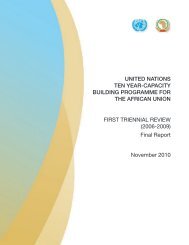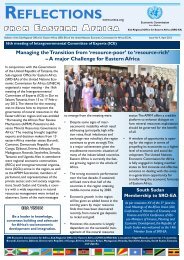Tool kit for Gender and Agriculture - Economic Commission for Africa
Tool kit for Gender and Agriculture - Economic Commission for Africa
Tool kit for Gender and Agriculture - Economic Commission for Africa
You also want an ePaper? Increase the reach of your titles
YUMPU automatically turns print PDFs into web optimized ePapers that Google loves.
18<br />
Improving <strong>Agriculture</strong> through <strong>Gender</strong> Analysis<br />
CHAPTER II: IMPROVING AGRICULTURAL DEVELOPMENT PROJECTS<br />
THROUGH GENDER ANALYSIS<br />
A. <strong>Gender</strong> Roles in the Farming System<br />
Women <strong>and</strong> men have distinct roles within the farming system. <strong>Gender</strong> differences in<br />
rural farming households vary widely across cultures (see Table 4), but certain features<br />
are common. Women tend to concentrate their agricultural activities around the homestead,<br />
primarily because of their domestic <strong>and</strong> reproductive roles; they play a critical<br />
role in food production, post-harvest activities, livestock care, <strong>and</strong> increasingly in cash<br />
cropping. Certain tasks, activities, or enterprises are regarded as “male” or “female.” In<br />
some settings, a rigid division of labor exists between men <strong>and</strong> women: household<br />
members have separate incomes <strong>and</strong> expenditures <strong>and</strong> reciprocal or skewed rights <strong>and</strong><br />
obligations. In others, the division of labor <strong>and</strong> specialization of tasks is less rigid <strong>and</strong><br />
not as skewed. In general, however, women tend to have a wider range of activities <strong>and</strong><br />
enterprises than men. On the one h<strong>and</strong>, they have productive activities in agriculture<br />
<strong>and</strong> livestock management; on the other, they have chief responsibility <strong>for</strong> reproductive<br />
activities, that is, the bearing <strong>and</strong> rearing of children <strong>and</strong> maintenance of the household.<br />
Although the gender-based division of labor in the farming system varies widely,<br />
it still affects responses to agricultural innovation everywhere.<br />
Table 4: <strong>Gender</strong>-Based Differences in <strong>Agriculture</strong><br />
Access to: <strong>Gender</strong>-Based Differences:<br />
L<strong>and</strong> L<strong>and</strong> title <strong>and</strong> tenure tend to be vested in men, either by legal<br />
condition or by sociocultural norms. L<strong>and</strong> re<strong>for</strong>m <strong>and</strong><br />
resettlement have tended to rein<strong>for</strong>ce this bias against tenure<br />
<strong>for</strong> women. L<strong>and</strong> shortage is common among women.<br />
Compared to men, women farm smaller <strong>and</strong> more dispersed<br />
plots <strong>and</strong> are less likely to hold title, secure tenure, or the same<br />
rights to use, improve, or dispose of l<strong>and</strong>.<br />
Extension <strong>and</strong><br />
training<br />
Women farmers have less contact with extension services than<br />
men, especially where male-female contact is culturally<br />
restricted. Extension is often provided by men agents to men<br />
farmers on the erroneous assumption that the message will<br />
trickle “across” to women. In fact, agricultural knowledge is<br />
transferred inefficiently or not at all from husb<strong>and</strong> to wife.<br />
Moreover, the message itself tends to ignore the unique<br />
workload, responsibilities, <strong>and</strong> constraints facing women<br />
farmers.<br />
Technology Women generally use lower levels of technology because of<br />
difficulties in access, cultural restrictions on use, or regard <strong>for</strong>







